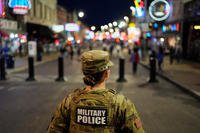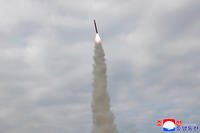If you're in a nursing home operated by the Department of Veterans Affairs, data shows you're about half as likely to contract COVID-19 as you are in a non-VA senior living facility, and 13 times less likely to die from the disease.
In the past year, 1,679 residents of VA nursing homes, which it calls community living centers or CLCs, contracted COVID-19, and 143 died "within 30 days after a positive test," according to the department.
With more than 30,000 American veterans living in these facilities, that translates to an infection rate of 5.47 per 100 people and a death rate of less than .5%.
Read Next: GOP Air National Guardsman in Congress: Convict Trump, Save America
Roughly one-third of the 1.4 million Americans living in a nursing home tested positive for COVID-19 in 2020, and the death rate was 6.5%, according to data published by AARP.
VA officials attribute the lower infection and death rates to implementing infection prevention and control measures as soon as the virus began spreading. The VA limited new admissions, quarantined veterans returning to their homes from medical care, restricted visitors and tested residents and staff regularly, VA officials said.
Late last year, then-VA Secretary Robert Wilkie described the decision to lock down nursing homes as one of the "hard choices" of the pandemic.
VA nursing home patients are among the most fragile Americans, with the majority of residents being World War II veterans.
"At this very tough time in their lives, we cut them off from families and friends but we did it in order to protect them," Wilkie said in an interview with Military.com.
He added that as a result of the low number of cases and deaths, VA was sharing "lessons learned ... with the rest of the country, particularly on the nursing home front."
The Government Accountability Office reported last week that 95% of the VA's 134 nursing homes had at least one issue with infection control in the five years preceding the pandemic.
According to the GAO, 365 infection prevention and control deficiencies were found at VA nursing homes from 2015 through 2019 -- including staff not washing their hands properly, not using gowns and gloves as recommended or failing to clean reusable medical items correctly.
"Many of these practices can be critical to preventing the spread of infectious diseases, including COVID-19," GAO analysts wrote in the report.
The review was conducted at the request of Democratic Sens. Jon Tester of Montana, and Edward Markey and Elizabeth Warren of Massachusetts. It follows media reports on the quality of care at VA nursing homes and scrutiny of an internal ratings system based on quality metrics tracked by the VA but not provided to veterans or families.
In one egregious case, a veteran died in 2019 at the VA's Eagles' Nest Community Living Center in Georgia, days after his daughter found him covered with more than 100 ant bites.
An investigation found that staff was aware of the fire ant infestation and other veterans had been bitten.
The VA moved the facility's 34 residents elsewhere last spring and closed the facility in December. It plans to build a new home in Atlanta.
According to the GAO, 62% of the VA's community living centers inspected had infection control issues in consecutive years and an additional 19% had them in multiple nonconsecutive years.
Roughly one-third had deficiencies in at least three consecutive years.
The GAO also found that VA inspectors classified all of the deficiencies as "not severe," meaning the inspector determined that residents were not harmed, even though at least one case involved poor hygiene among staff working with residents with active cases of Methicillin-resistant Staphylococcus aureus, or MRSA, a bacteria that can cause pneumonia and bloodstream infections.
The GAO sent the report to the senators and the VA but made no recommendations.
VA Spokesman Randy Noller said the department took corrective measures as a result of infection control deficiencies identified during unannounced surveys between 2015 and 2019.
According to AARP, the rate of COVID-19 infections among U.S. nursing home staff members was 9.3 per 100 people in December. The VA did not provide the breakout for employees who work at its community living centers, making it difficult to calculate the comparable rate.
As of Monday, 1,272 Veterans Health Administration employees were COVID-positive. Since the beginning of the outbreak, 18,725 VA employees have tested positive, and 125 have died.
Noller said the VA will continue to "enforce ongoing vigilant safeguards to protect the highly vulnerable community living center veterans."
The department has published a plan for facilities to follow in resuming in-person services and allowing visitation, which will vary by facility, he added.
Veterans living in VA community settings were in the first tier of those offered the COVID-19 vaccine by the department.
-- Patricia Kime can be reached at Patricia.Kime@Monster.com. Follow her on Twitter @patriciakime.
Related: VA's Complicated Vaccine Priority System Causes Disparities, Confusion












